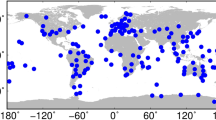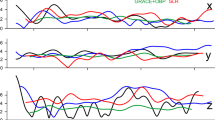Abstract
A time series of length of the day (LOD) and polar motion (PM) were estimated from the range data measured by the satellite laser ranging technique (SLR) to LAGEOS 1/2 through 1993 to 2006. Compared with EOPC04 released by the International Earth Rotation and Reference Systems Service (IERS), the root mean squares errors for LOD, X and Y of PM are 0.0067 milliseconds (ms), 0.18 milli-arc-seconds (mas) and 0.20 mas, respectively. Then the time series are analyzed with the wavelet transformation and least squares method. Wavelet analysis shows that there are the obvious seasonal and inter-annual variations of LOD and PM, but the annual variation cannot be distinguished from the Chandler variation because these two frequencies are very close. The trends and periodic variations of LOD and PM are given in the least squares sense. LOD changes with the annual and semiannual periods. The annual and Chandler variations for PM are also detected, but the semiannual motion for PM is not found. The trend rate of the LOD change in 1993–2006 is −0.18 ms per year, and the difference from the well-known 1.7 ms per century showed that the trend rate is diverse in different periods possibly. The trend rates of PM in the X and Y directions are 2.25 and 1.67 mas per year respectively, and the North Pole moves to 36.5°E relative to the crust, which is different from the direction of Greenland.
Similar content being viewed by others
References
Lambeck K. The Earth’s Variable Rotation: Geophysical Causes and Consequences. Cambridge: Cambridge University Press, 1980
Wells F J, Chinnery M A. On the separation of the spectral components of polar motion. Geophys J R Astr Soc, 1973, 34: 179–192
Ray J R. Measurements of length of day using the global positioning system. J Geophys Res, 1996, 101(B9): 20141–20149
Ray J, Kouba J, Altamimi Z. Is there utility in rigorous combinations of VLBI and GPS Earth orientation parameters? J Geod, 2005, 79: 505–511
Gambis D. Monitoring Earth orientation using space-geodetic techniques, state-of-the-art and prospective. J Geod, 2004, 78(4–5): 295–303
Gambis D. DORIS and the determination of the Earth’s polar motion. J Geod, 2006, 80: 649–656
Wahr J M. The Earth’s rotation. Ann Rev Earth Planet Sci, 1988, 16: 231–249
Eubanks T M. Variations in the orientation of the Earth. In: Smith E D, Turcott D L, eds. Contributions of Space Geodesy to Geodynamics-Earth Dynamics, Geodyn Ser, Washington, 1993, 24: 1–54
Johnson T J, Wilson C R, Chao B F. Oceanic angular momentum variability estimated from the parallel ocean circulation model 1988–1998. J Geophys Res, 1999, 104: 25183–25195
Dickey J O, Marcus S L, Johns C M, et al. The oceanic contribution to the Earth’s seasonal angular momentum budget. Geophys Res Lett, 1993, 20(24): 2953–2956
Barnes R T H, Hide R, White A A, et al. Atmospheric angular momentum fluctuations, length-of-day changes and polar motion. Proc R Soc London, 1983, 387: 31–73
Ma L H, Han Y B. Atmospheric excitation of time variable length-of-day on seasonal scales. Chin J Astron Astrophys, 2006, 6(1): 120–124
Höpfner J. Interannual variations in length of day and atmospheric angular momentum with respect to ENSO cycles. 22nd General Assembly International Union of Geodesy and Geophysics, Birmingham, 1999. 1–17
Gross R S, Fukumori I, Menemenlis D, et al. Atmospheric and oceanic excitation of length-of-day variations during 1980–2000. J Geophys Res, 2004, 109: B01406, doi:10.1029/2003JB002432
Chao B F, O’Connor W P. Global surface-water-induced seasonal variations on the Earth’s rotation and gravitational filed. Geophys J, 1988, 94: 263–270
Ponte R M. Barotropic motions and the exchange of angular momentum between the oceans and the solid earth. J Geophys Res, 1990, 95: 11369–11374
Ponte R M, Stammer D, Marshall J. Oceanic signals in observed motions of the Earth’s pole of rotation. Nature, 1998, 391: 476–479
Nastula J, Ponte R M, Salstein D A. Regional high-frequency signals in atmospheric and oceanic excitation of polar motion. Adv Space Res, 2002, 30: 369–374
Brzeziński A, Bizouard C, Petrov S. Influence of the atmosphere on Earth rotation: What new can be learned from the recent atmospheric angular momentum estimates? Surveys Geophys, 2002, 23: 33–69
Coulot D. SLR and combinations of space-geodetic solutions: Contribution to reference systems (in French). Ph. D. Thesis. Paris: Paris Observatory, 2005
Feissel-Vernier M, Le Bail K, Berio P, et al. Geocentre motion measured with DORIS and SLR, and predicted by geophysical models. J Geod, 2006, 80: 637–648
Le Bail K. Estimating the noise in space-geodetic positioning. J Geod, 2006, 80: 541–565
McCarthy D D, Petit G. IERS conventions (2003). IERS Technical Note No. 32, BKG Frankfurt, 2004
Feissel M. 1996 IERS annual report. Paris: Observatoire de Paris, 1997
Torrence C, Compo G P. A practical guide to wavelet analysis. Bull Am Meteorol Soc, 1998, 79(1): 61–78
Huber P J. Modeling the length of day and extrapolating the rotation of the Earth. J Geod, 2006, 80: 283–303
Trupin A S, Meier M F, Wahr J M. Effect of melting glaciers on the Earth’s rotation and gravitational field: 1965–1984. Geophys J Int, 1992, 108: 1–15
Trupin A S. Effects of polar ice on the Earth’s rotation and gravitational potential. Geophys J Int, 1993, 113: 273–283
Wahr J, Han D, Trupin A, et al. Secular changes in rotation and gravity: Evidence of post-glacial rebound or of changes in polar ice? Adv Space Res, 1993, 13: 257–269
Markowitz W. Concurrent astronomical observations for studying continental drift, polar motion, and the rotation of the Earth. In: Markowitz W, Guinot B, eds. Continental Drift, Secular Motion of the Pole, and Rotation of the Earth. Springer-Verlag, Dordrecht, 1968. 25–32
Markowitz W. Sudden changes in rotational acceleration of the Earth and secular motion of the pole. In: Mansinha L, Smylie D E, Beck A E, eds. Earthquake Displacement Fields and the Rotation of the Earth. New York: Springer-Verlag, 1970. 69–81
Yumi S, Wako Y. Secular motion of the pole. In: Mansiha L, Smylie D E, Beck A E, eds. Earthquake Displacement Fields and the Rotation of the Earth. New York: Springer-Verlage, 1970. 82–87
Wilson C R, Vicente R O. An analysis of the homogeneous ILS polar motion series. Geophys J R Astr Soc, 1980, 62: 605–616
Vondrak J, Ron C, Pešek I, et al. New global solution of earth orientation parameters from optical astrometry in 1900–1990. Astron Astrophys, 1995, 297: 899–906
McCarthy D D, Luzum B J. Path of the mean rotational pole from 1899 to 1994. Geophys J Int, 1996, 125: 623–629
Nagel S, Seitz T, Schuh H. Analysis of long time series of polar motion. DGFI, Nizza, EGS, 2000
Höpfner J. Atmospheric, oceanic and hydrological contributions to seasonal variations in length of day. J Geod, 2001, 75: 137–150
Höpfner J. Seasonal oscillations in length-of-day. 21st General Assembly European Geophysical Society, Hague, 1996. 1–8
Kouba J, Vondrak J. Comparison of length of day with oceanic and atmospheric angular momentum series. J Geod, 2005, 79: 256–268
Gu Z N, Paquet P. A possible contribution of the solar wind to annual fluctuation in the length of day. Earth Moon Planets, 1993, 62: 259–271
Author information
Authors and Affiliations
Additional information
Supported by the International S&T Cooperation Program of China (Grant No. 2006DFA21980), Hi-Tech Research and Development Program of China (Grant No. 2006AA12z303) and National Natural Science Foundation of China (Grant No. 40774009)
About this article
Cite this article
Guo, J., Han, Y. Seasonal and inter-annual variations of length of day and polar motion observed by SLR in 1993–2006. Chin. Sci. Bull. 54, 46–52 (2009). https://doi.org/10.1007/s11434-008-0504-1
Received:
Accepted:
Published:
Issue Date:
DOI: https://doi.org/10.1007/s11434-008-0504-1




